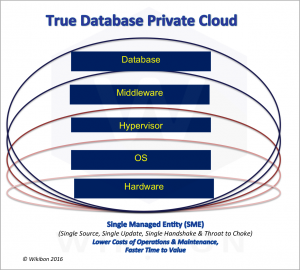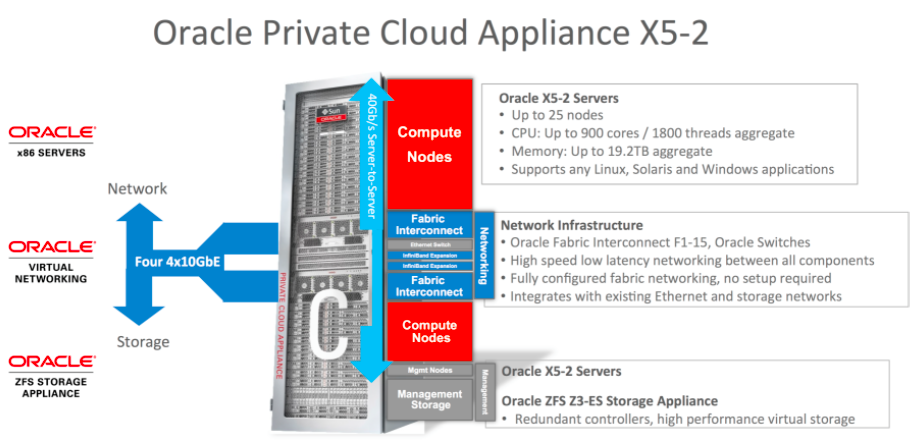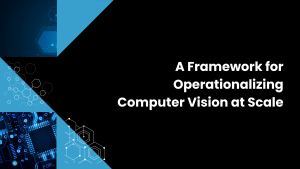Premise
Oracle is using it’s licensing might to enter the converged infrastructure (CI) market by making database pricing extremely attractive for its own Private Cloud Appliance (PCA), relative to alternative solutions (including non-Oracle public cloud options). To gain this pricing advantage, Oracle is delivering a competitive high-end solution and applying certain restrictions to some non-Oracle products, while at the same time allowing more licensing flexibility for virtualized environments on PCA. As such, customers that want to achieve this benefit must choose to adopt an Oracle appliance and run Oracle VM (OVM), versus adopting generalized CI solutions with alternative virtualization engines (e.g. VMware, KVM, Hyper-V etc.).
Introduction
Oracle’s PCA is a higher-end competitive response to converged infrastructure solutions such as EMC’s vBlock, NetApp’s FlexPod and others. PCA is a tightly integrated system of compute, storage and high performance networking, aimed at mixed workloads (albeit weighted towards Oracle), that provides greater pricing granularity and flexibility for virtualized environments. Specifically, Oracle is making licensing very attractive for customers willing to adopt OVM. Discussions with PCA customers indicate three main benefits, including: 1) reduced Oracle database license costs (of 50% or more); 2) greater flexibility to allocate processor cores to optimize workloads and 3) very high bandwidth and performance (via an Infiniband point-to-point architecture).
One of the promises of cloud computing is the simplification of IT. Wikibon has projected that “True Private Cloud” solutions will enable over $150B of IT operational costs to be shifted to vendors and platforms through tighter technology integration and increased remote operations by vendors. Solutions that include integration of the application stack lead the way for reducing complexity and increasing IT speed and agility.

Source: © Wikibon, 2016
Rack scale management with VM-level licensing
Wikibon has written extensively about how a Single Managed Entity (SME) is a foundation for reducing operational costs, enabling a True Private Cloud environment. The key characteristics of an SME solution are that it is easier to deploy, manage, and update the complete stack.
The “last mile” (traditionally the last thing tackled and a significant challenge in the past) of this full stack is the integration of application middleware (e.g., Oracle Database and Java) and the associated licenses. The overhead of testing, optimizing, and maintaining the total stack (application middleware integration into the underlying infrastructure) is one reason why many enterprise IT shops limit updates to their environments, so as not to risk bringing down the application or impacting business activities. Figure 1 illustrates the concept of a Single Managed Entity (SME), giving a single throat to choke from hardware microcode through to application database.
For Oracle databases, licensing considerations have led many users to deploy on dedicated equipment rather than a virtualized environment, despite strong business cases for the adoption of virtualization for production environments. In addition, best practice to minimize the number of Oracle licenses is to group all the licenses together on the same cluster(s).
With the addition of Oracle’s Trusted Partitions (available on Oracle Engineered Systems), a software license is now associated with two specific cores in a virtual machines (using Oracle VM), rather than pools of virtual processor cores. Service provider and enterprise customers of Oracle’s Private Cloud Appliance (PCA) are finding Trusted Partitioning to be transformational in their management of Oracle licenses. Sean Donaldson, CTO of Secure 24, said that the licensing flexibility in an OVM virtualized environment allows his company to deploy Oracle applications in a cloud model; Oracle RAC used to take four weeks to set up, and the organization can now deploy a fully redundant cluster in four hours.
Oracle Private Cloud Appliance
There has been a strong shift in the industry towards integrated offerings (converged infrastructure, hyperconverged infrastructure, etc.). While users are rightfully concerned about the costs and business outcomes, not all stacks are created equally. There is value and differentiation both in how deeply integrated the components of the solutions are, as well as the components within the solution.
A US-based service provider stated that the InfiniBand switching inside the PCA led to significant performance improvements. They had also moved its Oracle applications from a physical to an OVM virtual environment using Trusted Partitions. This improved the licensing efficiency 2:1, halving the number of licenses required. Although with Oracle this is not a direct saving, it means that the Oracle licenses can be used elsewhere. Their comment on performance: “it flies.”
Inside the PCA stack are the following:
- Up to 25 Compute Nodes, Oracle ZFS Storage, InfiniBand Networking (external linkage to 10Gb Ethernet and Fibre Channel (optional))
- Oracle VM supports Linux, Solaris and Windows
- Oracle VM Templates deliver application profiles for rapid deployment including Oracle Database, Oracle Fusion Middleware, Oracle E-Business Suite, JD Edwards
- The system comes pre-integrated with Oracle ZFS Storage Appliance and supports external iSCSI, NFS or Fibre Channel storage arrays
- Users found that using the internal ZFS Storage Appliance was a better overall experience than external third party storage arrays (tighter integration, fewer vendors to manage)
- Software in the stack includes Oracle Enterprise Manager 12c
- Self service provisioning
- Metering / Charge-back
- Upgrades to the system are done in a single patch
- Server, OS, networking, virtualization, and storage are a single ISO image
- The single patch upgrades do not include database and middleware, as would be the case with other Oracle engineered systems (e.g., Exadata, ODA, etc.)
PCA in the Hybrid Cloud
Oracle’s hybrid cloud strategy is to offer a broad portfolio of engineered solutions – the Exa-family and many appliances (including PCA) – that can be deployed in a customer data center, in hosted environments, or consumed through service providers. The same full stack is available in Oracle’s public cloud. Oracle’s stated strategy is to create a common operational model and experience between on-premises and public cloud. Wikibon has stressed that the business value of cloud is largely derived by improving the operational model versus where to put apps and data.
Advantages & Disadvantages of Oracle PCA
The main advantage of Oracle PCA as compared to traditional roll-your-own systems is the efficiency of the virtualized systems, the overall performance and robust architecture of the PCA, greater flexibility (e.g. apps and database can run on the same processor) and Trusted Partitions, which allow customers to dramatically reduce Oracle database licensing costs. Compared with Oracle Exadata systems, the Oracle PCA is more of a general purpose solution that allows the use of Oracle databases and other databases to be mixed on the same machine. This provides much greater flexibility to both service providers and IT operations. PCA addresses a main historical criticism of Oracle appliances, namely that their value proposition tends to be very narrow and largely “locks out” some third party solutions.
While PCA is at the higher end of the CI solutions spectrum, there is currently no integrated all-flash option. Other CI solutions offer this capability and for customers looking for the absolute lowest latency better alternatives may exist. As well, to take advantage of Oracle’s flexible licensing for PCA, customers must be comfortable investing in an Oracle appliance and virtualization roadmap.
Action Item
Users with Oracle applications should explore the Trusted Partitions functionality that is available through service providers or from the Oracle engineered solutions, such as Oracle’s Private Cloud Appliance. Solving Oracle licensing challenges can add a major (often overwhelming) benefit to the business case. Overall, PCA avoids significant roadblocks to creating an agile and cost-effective infrastructure foundation for building on-premise private cloud infrastructure.



